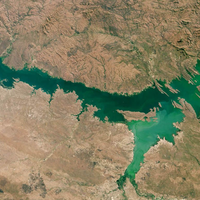ABOVE: Lago de Cahora Bassa in Mozambique, one of the lakes studied by the authors, with a green algal bloom
NASA EARTH OBSERVATORY, JESSE ALLEN
Freshwater phytoplankton blooms cause losses of more than $4 billion annually in the United States by disrupting the seafood industry, contaminating drinking water supplies, and harming water recreation and tourism, according to Anna Michalak of the Carnegie Institution for Science and colleagues. Algal bloom intensity has increased in 68 percent of sampled lakes worldwide since the 1980s, according to their study published in Nature October 14.

Michalak’s team partnered with Google Earth Engine to analyze 30 years of summer algal bloom data from NASA and the US Geological Survey’s Landsat 5 near-Earth satellite. The researchers examined blooms...
The mechanism behind the increase is unclear. Lakes with a decrease in intensity warmed less than others, suggesting that warming could be hindering lake recovery from dangerous algae and counteracting bloom management efforts, the authors write in the paper.

J.C. Ho et al., “Widespread global increase in intense lake phytoplankton blooms since the 1980s,” Nature, doi:10.1038/s41586-019-1648-7, 2019.
Emily Makowski is an intern at The Scientist. Email her at emakowski@the-scientist.com.
Interested in reading more?






